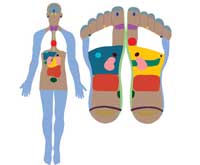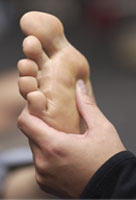What is reflexology?
Reflexology is the application of pressure to specific points and areas on the feet, hands, or ears. Reflexologists believe that these areas and reflex points correspond to different body organs and systems, and that pressing them has a beneficial effect on the organs and person's general health. For example, reflexology holds that a specific spot in the arch of the foot corresponds to the bladder point. When a reflexology practitioner uses thumbs or fingers to apply appropriate pressure to this area, it affects bladder functioning.
Although reflexology is not used to diagnose or cure health disorders, millions of people around the world use it to complement other treatments when addressing conditions like anxiety, asthma, cancer treatment, cardiovascular issues,diabetes, headaches, kidney function, PMS, and sinusitis.
According to several studies, a practice in Denmark resulted in reduced sick leave and absenteeism. Employees consistently reported complete or partial improvement in conditions where they sought reflexologists' help and even relief for additional problems related to stress. In one municipal district, almost one-third of the employees reported greater satisfaction with their jobs after completing six sessions with a reflexologist.
Where are the reflexology points and areas?
In reflexology theory, points and areas on the feet, hands, and ears correspond to specific organs, bones and body systems. Practitioners access these points on the feet and hands (bottom, sides, and top) and the ear (both inside as far as the finger can reach and outside) to affect organs and systems throughout the entire body.
Maps of reflex points have been passed between practitioners across the globe. Understandably, there is not agreement among all reflexologists on all points; however, general agreement does exist on major reflex points. Some scientific documentation of linkages between the skin and internal organs also exists.
To represent how the body systems correspond to one another, reflexologists use reflexology "maps." A good example of a reflexology map exists for the feet. Each foot represents a vertical half of the body:
 The left foot corresponds to the left side of the body and all organs, valves, etc. found there.
The left foot corresponds to the left side of the body and all organs, valves, etc. found there.
- The right foot corresponds to the right side of the body and all organs found there. For example, the liver is on the right side of the body, and therefore the corresponding reflex area is on the right foot.
The illustration to the right shows a reflexology map for the feet.
A reflexologist may perform a general session or may focus on specific problem areas on the feet, hands or ears.
Whatever the approach, the reflexologist attempts to release congestion or stress in the nervous system and balance the body's energy.
How does reflexology relate to other therapies?
Acupuncture and acupressure: Reflexology is similar to acupuncture and acupressure in that it works with the body's vital energy through the stimulation of points on the body. However, acupuncture/acupressure points do not always coincide with the reflex points used in reflexology.
 Reflexology and acupressure are both "reflex" therapies in that they work with points on one part of the body to affect other parts of the body. While reflexology uses reflexes that are in an orderly arrangement resembling a shape of the human body on the feet, hands, and outer ears, acupressure uses over 800 reflex points that are found along long thin energy lines called meridians that run the length of the entire body.
Reflexology and acupressure are both "reflex" therapies in that they work with points on one part of the body to affect other parts of the body. While reflexology uses reflexes that are in an orderly arrangement resembling a shape of the human body on the feet, hands, and outer ears, acupressure uses over 800 reflex points that are found along long thin energy lines called meridians that run the length of the entire body.
Massage: Some people confuse reflexology with massage. While both massage and reflexology use touch, the approaches are very different.
- Massage is the systematic manipulation of the soft tissues of the body, using specific techniques (for example, tapping, kneading, stroking, and friction) to relax the muscles.
- Reflexology focuses on reflex maps of points and areas of the body in the feet, hands, and ears using unique micromovement techniques such as thumb or finger walking and hook and backup to create a response throughout the body.
In short, massage therapists work "from the outside in," manipulating specific muscle groups or fascia to release tension. Reflexology practitioners see themselves as working "from the inside out" -- stimulating the nervous system to release tension.
Another difference between massage and reflexology is that a client will stay fully clothed for a reflexology session except for removing footwear, whereas clients remove clothing for a massage session.
Are There Times When I Shouldn’t Have Reflexology?
While reflexology is an extremely safe healing practice, it is important to be aware of a few contraindications or times when reflexology might not be a wise choice.
These contraindications include:
- Reflexology on the foot is discouraged in patients with foot fractures, unhealed wounds, or active gout in the foot. Patients with osteoarthritis that impacts the foot or ankle, or those with vascular disease of the legs or feet, should consult with their primary provider prior to beginning reflexology on the feet. An acceptable alternative would be to use reflexology on the hands and ears.
- Clients who report current thrombosis or embolism (which is an obstruction of the pulmonary artery or a branch of it by a free-floating blood clot or embolus) should not receive reflexology therapy. Since reflexology improves circulation, it could potentially cause a clot to move towards the heart or brain.
- For women in early pregnancy (the first 6 weeks), the reflexology session is altered by treating the uterine and ovarian reflex points more gently or by avoiding them altogether. In general, caution should be exercised during pregnancy because of reports that stimulation may cause contractions.
- Babies and young children will receive benefit from many techniques, but rarely have the patience for a whole session. Thus, sessions are abbreviated in length.
- If you are using other touch therapies, such as massage, allow at least 48 hours between touch therapy sessions to avoid an overload on your system.
Hope you find this information helpful. I have doing some training as well as previous research on reflexology. I am not certified yet, but plan to be once I can attend a class focusing on this technique.
Yours in Wellness,
Heather Miracle LMT
While reflexology is an extremely safe healing practice, it is important to be aware of a few contraindications or times when reflexology might not be a wise choice.
These contraindications include:
- Reflexology on the foot is discouraged in patients with foot fractures, unhealed wounds, or active gout in the foot. Patients with osteoarthritis that impacts the foot or ankle, or those with vascular disease of the legs or feet, should consult with their primary provider prior to beginning reflexology on the feet. An acceptable alternative would be to use reflexology on the hands and ears.
- Clients who report current thrombosis or embolism (which is an obstruction of the pulmonary artery or a branch of it by a free-floating blood clot or embolus) should not receive reflexology therapy. Since reflexology improves circulation, it could potentially cause a clot to move towards the heart or brain.
- For women in early pregnancy (the first 6 weeks), the reflexology session is altered by treating the uterine and ovarian reflex points more gently or by avoiding them altogether. In general, caution should be exercised during pregnancy because of reports that stimulation may cause contractions.
- Babies and young children will receive benefit from many techniques, but rarely have the patience for a whole session. Thus, sessions are abbreviated in length.
- If you are using other touch therapies, such as massage, allow at least 48 hours between touch therapy sessions to avoid an overload on your system.
Hope you find this information helpful. I have doing some training as well as previous research on reflexology. I am not certified yet, but plan to be once I can attend a class focusing on this technique.
Yours in Wellness,
Heather Miracle LMT

